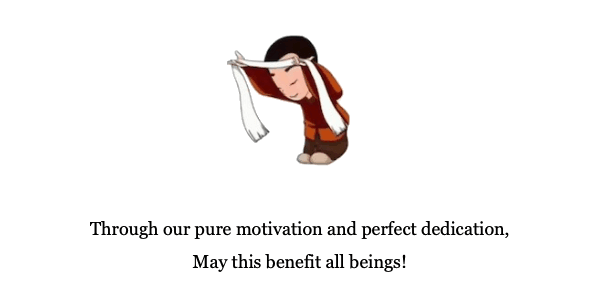07-Habitual patterns Obscuration
From day to day, our appurtenances to samsara is felt through the many obstacles that we are facing to achieve our goal to be enlightened. Good intent is not enough, and it might be relevant to ask ourselves why is it that we experience these obstacles?
For a start, from birth to birth, we are subjected to
བག་ཆགས་ཀྱི་སྒྲིབ་པ། - “Bag-Chag-Kyi Drib-Pa” - “Habitual Patterns Obscuration"
Defilement is of course a habit creating countless setbacks; but it is a little bit different than “Bag-Chag-Kyi Drib-Pa”. Defilement is more foreseeable and can also be dealt with. Nowadays, there are countless methods and treatments available to assist one to deal efficiently with defilement.
‘Bag-Chag-Kyi Drib-pa’ is a very subtle obstacle. It can be compared to our own ‘inheritance’ from past deeds of body, speech and mind. It is the karmic residue that we have left unresolved from countless lifetimes. As such, it is the first of the four obscurations that are hindrances to realization.
From a Mahayana or Great Vehicle perspective, these are described as follows:
-
ལས་ཀྱི་སྒྲིབ་པ།- ‘Lay-kyi Drib-pa’ - “karmic obscuration";
The direct result of our past unresolved karma is recorded in the alaya consciousness and manifest from life to life as “Bag-Chag-Kyi Drib-Pa” which consists in our spontaneous answer to situation and dictates the ground of our behaviour. See below for further explanation as this is the main topic of this note.
-
ཉོན་མོངས་པའི་སྒྲིབ་པ།- ‘Nyön-mong-pa’I Drib-pa’ - “emotional obscuration";
Emotional obscuration is the direct ‘skin reaction’ level of interacting with the phenomenal world. It is the outcome of lacking mind training and dealing with reality through the conflicting emotion of anger, pride, greed, jealousy and ignorance. It does take much merit, effort and training to free oneself from the grip of basic ignorance. Basic ignorance is ignoring the fact of emptiness. Both, emptiness of self and emptiness of phenomena. In solidifying and addressing separately these two, the self and phenomenal world, we are caught in an illusory world where everything appears as difficult and unmanageable. From there, our conduct is governed by our emotions. This situation works as the basis of samsaric world. It can be changed depending on a conscious course of actions of body, speech and mind. This takes place as we engage on the Path to liberation starting with “Dzog-Lam”.
-
ཤེས་བྱའི་སྒྲིབ་པ།- ‘Shey-ja’i Drib-pa’ - “cognitional obscuration";
The cognitional levels of obscuration come next and are exclusively dealt with the Path of Meditation. This Path is only accessed once one has thoroughly achieved the realisation of emptiness. Not just a mere mental glimpse at the concept of it!
-
སྙོམས་འཇུག་གི་སྒྲིབ་པ།- ‘Nyom-jug-gi Drib-pa’ - "equilibria obscuration".
“Nyom-jug-gi drib pa” is the obstacle that we experience at first as we want to engage the Path of Meditation. The reason is simple: we have been from life to life trained in the opposite of it. Caught in the three previous types of obscuration, we have not developed the ability to remain calm and clear and suffer now from the habit of our personal neurosis.
Let’s now go back to the subject of our habitual patterns and more precisely, that of ‘Bag-Chag-Kyi Drib-pa’. An example is the way we project our own thoughts, feelings, or motivations on others. This can be very difficult to see and overcome, and it takes effort to do so.
When we always find ourselves making the same mistake by misunderstanding others and judging them in an inaccurate, stupid, or non-compassionate way, we are being blocked by this habitual pattern. Later we find out that we were wrong, but usually by then it’s too late, the damage is done. We can only learn from the mistake.
These are subtle habitual obstacles stemming directly from the concept of “I”; the same “I” that we cling to in the Bardo of becoming and the Bardo of taking birth.
Studying the present topic has much meaning once we have decided to achieve enlightenment. However, it seems nowadays that most people, including so-called “Dharmas practitioners”, have not come to this point yet. They consider “Dharma” as a nice, higher way to entertain their life and get a so-to-say “smart social-network”. This is kind of nice and ‘ok’, yet it is not enough to achieve Buddhahood.
On the contrary, those who strive genuinely toward enlightenment, come to reach a state called:
བག་ཆགས་བསོགས་ལོང་མེད། - ‘ Bag-Chag-Sog Long-Med’ -“Without any spike (or surge) of latency accumulation".
When the authentic view has been realized, appearances occur but, because of the realisation that one has gained, they are unified appearance|emptiness. There is no sudden occurence of ‘Bag-Chag’ latency accumulation, at the very moment appearances manifest.
The realisation of ‘Bag-Chag-Sog Long-Med’ will lead to the realisation of “Ngey-Jung” or the true state of renunciation.
ངེས་པར་འབྱུང་བ། - ‘ Ngey-par Jung-wa’ - "niḥsaraṇa” (Skt). - “Definite occurrence of cessation" usually translated as "renunciation".
"Definite emergence". "niḥsaraṇataḥ" i.e. the fourth of the four aspects of the truth of cessation, referring the complete cessation of the third Noble Truth, stating that the process to have gone to nirvāṇa, has occurred with certainty".
For any being to enter the path to cessation, the person must go through a fourfold process as follows:
- To see clearly that cyclic existence is not pleasant but only unsatisfactory;
- To take the step of turning their mind away from it;
- To take the step of turning their mind towards obtaining emancipation from it;
- The complete occurrence of turning away from cyclic existence because of seeing it to be unsatisfactory and having turned towards emancipation (ངེས་འབྱུང་། - renunciation).
The real meaning of ཡིད་ངེས་པར་འབྱུང་བ། is that one has become certain of how things are and hence has become positive of the direction that one will take.





